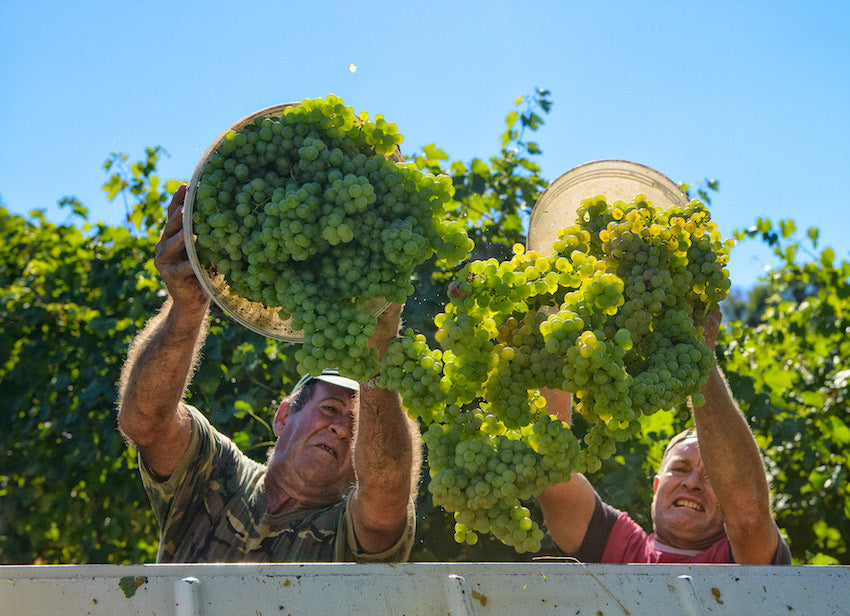In recent years, there has been growing attention to the concepts of sustainability, respect for the territory and the surrounding environment both on the part of consumers and wine producers. This is why we talk more and more about organic. But what exactly does that mean? Let's find out together through simple questions and as many answers.
Producing organically means many things: one of the most significant aspects is valorising the characteristics of the vine to the maximum degree and therefore guaranteeing a product as healthy and natural as possible. Let's see everything there is to know about organic wines.
What are organic wines?
A wine is organic when it comes from 100% organic grapes , i.e. grown without the use of chemicals and herbicides in the vineyards, while in the cellar production must take place with a limited use of sulphites and with the use of certified organic wine products .
Since when can organic be written on the label?
Organic production began to be regulated at community level around the 1990s (with EC regulation 2092/1991) but only since March 2012, with EC law 203/2012 , did organic wine obtain recognition and legal protection. Since then we have been able to speak and write "organic wine" on the label, whereas until then an organic wine had to bear the words "wine from organic grapes".
With this legislation the word organic is certified to indicate the set of criteria that concern the entire process of winemaking and transformation of the grapes. Organic winemaking also defines the maximum quantity of sulphites that can be present in the wine, to a slightly lower extent than in traditional wines. The maximum quantity of sulphites for organic wines is 100 mg/l for red wines and 150 mg/l for white and rosé wines, with the possibility of increasing them by 30 mg/l if the wine has more than 2 grams of residue sugary.
How is organic wine produced?
Organic products are created by agricultural production processes that exclude the use of synthetic chemicals . Organic wine is produced with grapes grown without the help of synthetic chemicals (fertilizers, herbicides, fungicides, insecticides and pesticides in general) and without the use of genetically modified organisms. Only copper and sulfur based treatments are permitted.
What are the objectives of those who produce organic wine?
The objectives of the organic production method are: respect natural balances, avoid pollution of air, land and water; safeguard biodiversity and natural resources .
How do you obtain organic certification?
In Italy, obtaining organic certification is an important process: companies are subjected to rigid controls by the competent bodies, which certify the companies' compliance with legal obligations. From the care of the vineyard to bottling, an organic wine is controlled by specific authorities who certify its requirements and characteristics, and who ultimately assign the relevant certificate to the producing winery. A wine that is presented to the consumer as organic therefore does not contain additives that are dangerous to health and has also been processed using techniques that safeguard biodiversity and the natural balance of the land.
How can you recognize organic wines?
Consumers can recognize organic products because they have the wording on the label .
What organoleptic characteristics do organic wines have?
The main characteristic of an organic wine is to enhance the characteristics of the grape to the maximum degree. The absence of synthetic chemicals allows the vine to be enhanced . Generally speaking, freshness, lightness and drinkability are predominant elements in an organic wine.
Organic in Italy
The organic wine market in Italy is constantly expanding : not only due to the number of wineries involved and thanks to a consumer profile that is increasingly attentive to what they consume and the impact this has on the environment and the ecosystem. Growth is expected in the medium to long term: Italy is one of the countries most sensitive to the issue.
The organic vineyard area in production is currently (beginning of 2022) 84 thousand hectares , up by 13%. Together with the 25 thousand hectares in conversion (instead a decrease of 20%) we reach a total of 109 thousand hectares, 17% of the vineyard area.
Organic concepts to know
Compost
It is a substance created by the aerobic decomposition of materials usually considered waste . Among these: food scraps, manure, leaves, straw, spent pomace, stalks, etc.
Composting occurs when carbon-rich materials such as straw and leaves are mixed with nitrogen-rich materials, such as food scraps and manure. To this we add oxygen, time, the help of billions of microorganisms, and the result is a crumbly, fragrant and nutrient-rich mixture.
Conventional farmers tend to use fossil fuel-intensive petroleum-based synthetic fertilizers that can pollute groundwater and harm wildlife. Organic farmers instead rely on inputs such as compost, which drastically reduces the need for chemical inputs, while also encouraging the recycling of waste materials.
Compost is incorporated into the soil , providing a variety of microorganisms and nutrients that promote healthy plant growth.
Green manure
Agricultural practice of high ecological value which consists in cultivating essences destined to be buried in the ground when they are at their peak. The goal is to restore nourishment to the earth and improve its structure without the use of chemicals or invasive processes.
The buried biomass has a positive impact on the soil: the plants, decomposing slowly, provide organic substance which is transformed into humus, improving the fertility and structure of the soil, mineralized by soil microorganisms.
The most suitable plants for green manure are legumes, because they spontaneously produce nitrogen which they release into the soil through their roots. Therefore: clovers, sulla, gorse, alfalfa and alfalfa, vetch, sainfoin, fodder pea, lupine, broad bean, vetch in the two sativa and villosa varieties... which is always recommended to mix with other species to promote biodiversity.
Grassing of the vineyard
Very widespread agronomic technique in organic farming. It consists of covering the land occupied by the main crop with a herbaceous cover, controlled through periodic mowing .
It serves to preserve the land from erosion by atmospheric agents (water and wind cause soil loss in worked land). The grass cover protects from erosion thanks to the root system of the herbaceous essence. Furthermore, grass cover has other advantages: increase in soil fertility, improvement of soil structure, decrease in necessary soil treatments, increase in water stagnation, control of plant vigor, increase in biodiversity. Are there any disadvantages? Yes, especially in the case of dry, non-irrigated land, the risk is that competition will be created between grass and plants. In this case it is better to opt for green manure, which is periodically buried.




